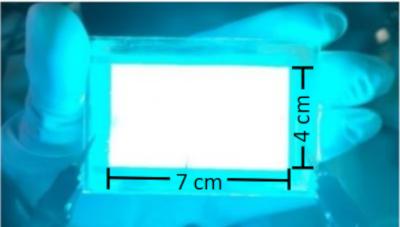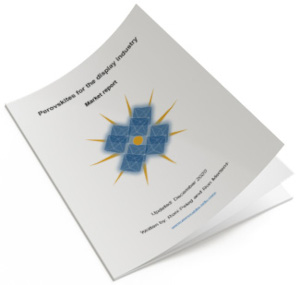Perovskite LEDs - recent news - Page 6
The MicroLED Industry Association to host a Perovskite microLED technology webinar
On March 27 the MicroLED Industry Association will host a private webinar on perovskite materials for the microLED industry. Perovskite materials hold great promise for the solar industry and in recent years we are seeing promising signs for the adoption of perovskites the display industry.

The upcoming Seminar will feature four world-leading speakers, and will also be open to a Q&A session. We will learn more about the state-of-the-art perovskite research and development, with a focus of course on applications in the microLED industry - for both perovskite QDs and PeLEDs.
Researchers develop bright, efficient and stable perovskite light-emitting diodes
Researchers from Korea's PEROLED, Seoul National University and Korea Basic Science Institute (KBSI), along with scientists from the UK's University of Cambridge, have reported an ultra-bright, efficient and stable perovskite LED made of core/shell perovskite nanocrystals with a size of approximately 10 nm, obtained using a simple in situ reaction of benzylphosphonic acid (BPA) additive with three-dimensional (3D) polycrystalline perovskite films, without separate synthesis processes.
During the reaction, large 3D crystals are split into nanocrystals and the BPA surrounds the nanocrystals, achieving strong carrier confinement. The BPA shell passivates the undercoordinated lead atoms by forming covalent bonds, and thereby greatly reduces the trap density while maintaining good charge-transport properties for the 3D perovskites.
Researchers develop high-resolution perovskite nanocrystal patterning technique for displays
Researchers from the Ulsan National Institute of Science and Technology (UNIST) have teamed up with researchers from Daegu Gyeongbuk Institute of Science and Technology (DGIST) to develop a patterning technique for the production of perovskite nanocrystal displays which are ultra-thin and high-resolution. The production involves a very simple stamp-like printing process that will facilitate the commercialization of the new technique.
Double-layer transfer printing process with RGB pixelated arrays of PeNCs. Image from Science Advances
The technique reportedly enabled the team to produce a display with RGB pixel patterns of 2,550 pixels per inch, which is about 400 percent higher resolution than the latest high-end smartphones.
Researchers utilize nano-optical designs for high-efficiency perovskite–silicon tandem solar cells
Researchers from Helmholtz-Zentrum Berlin (HZB) and Potsdam University have reported perovskite–silicon tandem solar cells with periodic nanotextures that offer various advantages without compromising the material quality of solution-processed perovskite layers. Textured tandem devices have been presented before, aiming at improved optical performance, but optimizing film growth on surface-textured wafers has thus far remained challenging.
The research team showed a reduction in reflection losses in comparison to planar tandems, with the new devices being less sensitive to deviations from optimum layer thicknesses. The nanotextures also enabled a greatly increased fabrication yield from 50% to 95%. Moreover, the open-circuit voltage was improved by 15 mV due to the enhanced optoelectronic properties of the perovskite top cell. The optically advanced rear reflector with a dielectric buffer layer resulted in reduced parasitic absorption at near-infrared wavelengths. As a result, the team achieved a certified power conversion efficiency of 29.80%.
The Perovskite for Displays Market Report updated to September 2022
Perovskite-Info is proud to announce an update to our Perovskite for the Display Industry Market Report. This market report, brought to you by the world's leading perovskite and OLED industry experts, is a comprehensive guide to next-generation perovskite-based solutions for the display industry that enable efficient, low cost and high-quality display devices. The report is now updated to September 2022, with all the latest commercial and research activity.
Reading this report, you'll learn all about:
- Perovskite materials and their properties
- Perovskite applications in the display industry
- Perovskite QDs for color conversion
- Prominent perovskite display related research activities
The report also provides a list of perovskite display companies, datasheets and brochures of pQD film solutions, an introduction to perovskite materials and processes, an introduction to emerging display technologies and more.
Researchers develop strategy for perovskite-based blue LEDs
A Florida State University research team, led by FSU Professor of Chemistry Biwu Ma, has developed a simple and effective approach to create an efficient and stable blue light from metal halide perovskites.
Scientists have already created highly efficient and stable perovskite-based LEDs for green and red light, but an efficient and stable blue light has been difficult to achieve. Blue light requires a lot of power, and the blue color purity often decreases over time. An efficient and stable blue light is crucial for creating white light.
Researchers successfully tackle the stability issue of perovskite LEDs
Perovskite LEDs can be produced quite easily and at low cost. They show great promise as they are lightweight and can offer flexibility compared to OLEDs, with color purity and tunability similar to LEDs based on III-V semiconductors. However, the poor device stability of perovskite LEDs will have to be overcome before commercial applications can emerge. Typical lifespans of perovskite LEDs are on the order of 10 to 100 hours. In contrast, the minimum lifetime required for an OLED display is 10,000 hours. It is currently challenging to reach this threshold, as halide perovskite semiconductors can be intrinsically unstable due to the ionic nature of their crystal structures—the ions can move around when voltages are applied to the LEDs, leading to material degradation.
In their recent work, a research group led by Prof. Di Dawei and Prof. Zhao Baodan at the College of Optical Science and Engineering of Zhejiang University discovered that by using a dipolar molecular stabilizer, it is possible to make efficient and stable perovskite LEDs with ultralong lifetimes, satisfying the demands of commercial applications. The research was carried out in collaboration with the research groups of Prof. Li Cheng at Xiamen University, Prof. Hong Zijian at Zhejiang University, and Prof. Li Weiwei at NUAA and formerly at Cambridge University.
Researchers develop a method to achieve large-area efficient perovskite LEDs
A research team at Seoul National University, led by Prof. Tae-Woo Lee, has developed highly efficient large-area perovskite light-emitting diodes (PeLEDs) with an external quantum efficiency (EQE) of 22.5% and pixel size of 102 mm2.
Professor Tae-Woo Lee's research team developed the scalable coating method of perovskite nanocrystals to make uniform large-area emitting films that helped fabricate these highly efficient large-area PeLEDs.
Researchers develop novel method to fabricate perovskite-based light-emitting diodes using quantum confinement
Researchers from The Hong Kong University of Science and Technology, Heilongjiang University, City University of Hong Kong and Sun Yat-sen University have developed a novel technique to fabricate perovskite-based light-emitting diodes using quantum confinement.
According to theory, by adjusting the compositions of the halide being used, i.e., iodine, bromine, and chlorine, the color of the emission may be fine-tuned. Nevertheless, color instability caused by migration of ions and separation in blended halides impedes the future development of perovskite-based LEDs, particularly blue perovskite-based LEDs, which require significantly higher voltages for proper operation. A potential strategy for achieving color controllability in perovskite-based LEDs is to use perovskite-based nanostructures which utilize quantum confinement.
Applications of perovskite materials in the display industry
This article was extracted from the Perovskite for Displays market report.
Given perovskites materials' unique optical properties, these materials are being intensively researched for both photovoltaic and display applications (as well as several others). In this article we will take a look into the possible application areas in the display industry that can benefit from perovskite materials.
Perovskite QDs
Perovskite-based QDs (PerQDs) are considered a viable Cd-free alternative for display applications, with high PL quantum yields, wide wavelength tunability and ultra-narrow band emission. The main advantages of PerQDs are:
- Low cost
- High performance
- RoHS compliance (despite the lead content)
Pagination
- Previous page
- Page 6
- Next page






